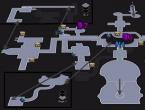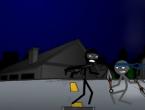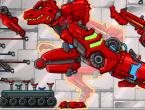Ashes of the singularity of strategy. Ashes Of The Singularity - Tour
Ashes of the Singularity is a real-time strategy game from developers Oxide Games. It's fair to say that the Nitrous game engine and the game itself were created with the participation of Stardock Entertainment, which in turn released such successful projects as Galactic Civilizations and Sins of Solar Empire. The strategy genre is fading, and it’s becoming less and less common to see a new game that has a lot of hype around it. Before us is the most typical strategy with one exception, dozens of units were replaced by hundreds. A distant future setting and a war for resources.
Trailer dedicated to the release of the game
A long time ago, in a galaxy far, far away!
2178 Technological progress has gone beyond human control. Turinium, a resource necessary for people, can be obtained by processing other planets. A coalition of humans remotely send robots into battle against other inorganic humans who are subordinate to the AI The Substrate.In short, people send robots against robots to war for a resource that both need. There is no plot here.
Gameplay trailer
The most ordinary strategy... Almost...
At the beginning of the game you have the main Nexus building and several engineers. Engineers are your builders, equip resource deposits. They also construct buildings and repair units.All your buildings in the game are connected by a yellow path. By conquering new regions, you create a connection between the resources of other regions and your Nexus.
Economy
Probably too strong a word for local interaction with resources. Each controlled deposit brings resources, in order to increase growth, it is necessary to equip them. Your resource has three indicators: its income/expenses, current availability, and capacity. When you build buildings or units, there are costs. Try to maintain a balance between capacity and zero balance, rebuilding buildings and units at peak productivity.
There are only 4 resources, 2 primary ones
- Metal is the first simple resource, a material for constructing buildings and units. It is mined in deposits.
- Radioactive assets are the second simple resource, spent on fuel for improved buildings and units.
- Turinium - Some regions may contain Turinium generators, which may be a win condition.
- Quanta is a super resource used to improve all technologies. Also allows you to use global Nexus abilities.
The map is divided into regions where resources and generators are located. They will be protected by neutral troops, after clearing the neutrals will eventually return, and you need to protect your network of resources. In addition to neutral units, you will have a specific enemy or several at once. Different buildings produce different units: flying, ground, scouts, etc. Flying units will provide reconnaissance and cover from the sky. Ground attack at short and long ranges. Others provide support in battle. On planets with low gravity, it is possible to plan battles at height. Each combat unit has range, speed and damage indicators.

Victory Conditions
As in all strategies, destroy all opponents or control the required amount of Turinium. If you accumulate enough resources, you will have the opportunity to build one of the global weapons.
- Call an engineer. At the beginning of the game, engineers can only be created in the Nexus. As your territories expand, you will move further and further away from the Nexus. So, you can spend the Quanta resource on calling engineers wherever you want.
- Players can build a building that can teleport units to a designated location by spending a Quantum resource. This can allow you to attack the enemy's flank.
- Orbital strike - everything is clear here, it wastes Quanta.
- Orbital shield.
Not exactly Star Wars...
At first glance, it's hard to believe that this is a game from 2016. The space strategy game has a clunky appearance and crooked controls. Do you remember what six-year-old Starcraft II looks like, in which all the graphic elements synergize and create a single picture? What controls does Blizzard's strategy have? Here everything is the other way around.Appearance
The most soapy landscape I've seen in a while. And plastic, tacky spacecraft roll around the soapy landscape and shoot with all the colors of the rainbow. This has nothing to do with the graphics settings and the selected terrain. Is it really difficult to make developers friendly with the color scheme and create not a teenager’s fantasy, but a rich, bright picture? There are many good examples among space games: the Mass Effect series, Dead Space, and again Starcraft. In Ashes of the Singularity, every object looks like a foreign body; you want to destroy them more than develop them.

The sound and music are done well, but you shouldn't expect anything special.
Control
I can't find the right words. Each order is given with a delay, and you won’t think that this happens at a good frame rate. Models of interaction with the game world and the player (collision models) do not coincide with texture models. You can click on a building, but it will not be highlighted. Every action causes torment, maybe it will go away with habit.

You can move the camera away and watch the process
All of the above can be fixed. But isn’t it easier to do something well right away than to correct it later? Apparently, the developers are not looking for easy ways.
Meta units
All identical units are united in groups, each behaving like the others. The game interface makes it easy to assemble similar groups; by selecting one, the entire battle group will be highlighted. Combat units do not crowd, but are very cleverly distributed along the front line, like water spilled on the floor. Engineers behave the same way during construction.
Everything's in business
“In the real world, a flying bomber is individual, it has weapons, radar, warheads. But in our game, you can add your bomber to a meta-group. And all units will behave based on the resources of the entire meta-group.”
The developers want to say that instead of controlling a unit, you have control of a “pack”, and the game itself knows how this “pack” should behave. You can focus on a global war, you don't have to manage each "pile" of 5 units like in other RTS.
According to the developers, the Nitrous engine is capable of simulating battles involving up to ten thousand individual units. Sounds great, but I tested hundreds of units on the GTX 970+Corei5 4570, and the game does not provide the required performance at maximum quality settings, what is needed for thousands of them?
Conclusion
Ashes of the Singularity is not easy to recommend to anyone other than strategy fans. The game can be forgiven for its graphical neglect, given that the emphasis is on depicting a larger number of combat units. Yes, this can be considered as an interesting feature, if you don’t put bread in your mouth, let me play strategy. The mechanics of advancing and capturing territory are also interesting. The “strategists” have already decided everything themselves, but for the rest, with the game’s price of 699 rubles, I advise you to pass it by.Game developers don't often release big games these days.DLC that corrects shortcomings pointed out by the player community. It can't be done without patches, but many people forget even about them after release. CompanyStardock is not one of them - decideproblems of the originalAshesoftheSingularity she decided in additionEscalation.
It’s worth saying right away that Ashes of Singularity: Escalation is not a continuation of the original game, but rather a work on bugs. Having studied the criticism of the first part, Stardock released the game eight months later with the same basic mechanics, making it more diverse and tactically deeper.
Ashes of Singularity is an RTS inspired by the legendary . Huge spaces, large-scale battles, high-tech mechanisms and an economic system, simplified so that you are not distracted from the constant meat grinder.
If you already have the originalAshesofSingularity, then it can be upgraded toEscalation at a significant discount.
The game primarily focuses on online battles, so the original was largely criticized for its mediocre single-player campaign, made for show. Escalation tried to correct this issue. Two game campaigns tell the story of the confrontation between people and a group called Prion, in which humanity will be helped by a surprisingly good-natured artificial intelligence. In general, the campaigns don’t have enough stars in the sky, but they won’t let you get bored either. Almost every mission will have unique tasks like capturing resources, which will dilute the banal goals in the spirit of “destroy the enemy.” At one time, such formulaic missions were more like standard skirmish than a full-fledged single-player campaign.

There are more videos in the game, and the dialogues are well voiced, although they do not provide a lot of information. In principle, in this kind of strategy, the background or detailed scenario is not so important. This is a game about battles and nothing else. And in this regard, Escalation is one of the best this year.
Direct competitorAshesofSingularity -new , which operates mainly with the same mechanics and is even visually similar to the projectStardock. But there is an important difference -Homeworld relies specifically on the story campaign.
The main advantage of Ashes of Singularity is its scale. If in the original the maps were already one of the largest in the history of RTS, then in Escalation they grew by another quarter. But the point is not even the size of the battlefield, but the fact that almost every part of it is full of fights, in which up to 16 people can participate at the same time. Why do you have to fight for every corner of the map? Because of the provincial system. The entire map is divided into areas that can be captured, gaining access to two game resources - metal and radioactive elements.
In addition, the number of units involved in even ordinary squabbles can reach hundreds. Compared to the original, their variety has increased significantly. This is largely due to the introduction of aircraft, but there are some newcomers to the ground units as well, and several older designs have taken on a more futuristic look.

However, most of the changes concern balance. Finally, in Ashes of Singularity, defensive structures have become operational. And if earlier Rush reigned supreme with some frigates, now you will have something to stop them. Turrets have been upgraded and become more powerful. Anti-aircraft guns can nip in the bud a fairly powerful air attack, which has become very popular in Escalation due to the appearance of bombers. However, there are still problems with the overall balance. Most of them involve one part of your technique being rendered useless by over-boosting another.
In the originalAshesofSingularity's major problem was the lack of differentiation between races in the game. Alas,Escalation doesn't change things much.
The main novelty, however, is more about planning than battles. Finally, a sane strategic view has been added to the game, like in the new Homeworld. You ascend to the level of the orbital station and control troops, represented as icons on the tactical screen. Unfortunately, the terrain is difficult to understand in this mode, so you have to descend to the level of normal skirmishes quite often.

Overall, Ashes of Singularity is a game of suppression. You capture provinces, gain an advantage, and destroy the enemy. It is quite difficult to win solely through tactical skill or an effective economic system. Quantity and strategic planning play a role. And, of course, the winner will be the one who will be more practical in managing super-units - dreadnoughts. Even a losing player can change his position by releasing these titans onto the battlefield in time, who, of course, still need support. The balance of the parties in Escalation changes very dynamically, and you shouldn’t leave even a weak opponent without attention.
A large-scale real-time strategy game that takes players into the distant future. A key feature of the game is the ability to conduct grandiose space battles involving several tens of thousands of units. In this case, each shot of a specific unit will be processed separately, and each fighter will receive its own damage.
Plot
In the 21st century, people managed to create full-fledged artificial intelligence. It turned out to be very useful and helped humanity reach a new technological level. With its help, people managed to transfer their minds into a shell called Computronium. The previous bodies became an ordinary tool that allows one to interact with the world.
The Computronium material was not just a human shell. The level of intelligence depended on the amount of this substance. And therefore it is not surprising that people tried to get as much of it as possible. Soon its resources on Earth and its satellite dried up, which forced people to start exploring new planets.
At the same time, all of humanity was divided into two hostile factions: some wanted to completely abandon the bodily shell, others wanted to maintain contact with their body. A brutal and bloody war soon broke out between the factions.
Game Features
Players will lead large-scale battles involving tens of thousands of units simultaneously. Moreover, each shot of any, even the tiniest unit, is a separate dynamic light source, and each combat unit on the battlefield receives individual damage.
Control
With thousands of units involved in planetary-scale battles and battles taking place on multiple fronts, players won't have time to micromanage. They will be able to combine squads into “meta-squads”, consisting of combat units of different classes. Moreover, each group that makes up the giant meta-squad will perform individual tasks on the battlefield and coordinate its actions with its allies. Players are solely responsible for controlling these armadas.
Multiplayer
The game will feature an exciting story campaign, as well as multiplayer battles. In this case, 1x1, 2x2, 1x1x1x1 modes will be supported.
Developer and Publisher: Stardock Entertainment.
Genre: RTS with benchmark elements.
Similar games: Supreme Commander, Total Annihilation.
Platforms: PC.
Minimum system requirements: Win 7 64, 4-core processor, 6 GB RAM, GeForce 660 or R7 360, 13 GB hard drive.
Recommended: Win 10 64, Core i5, 16 GB RAM, GTX 970 or R9 390.
Multiplayer: yes.
The wonderful era of the PC, which reached its apogee in 2005, gave us toys that were insanely ambitious, full of bugs, and incomprehensible to about half of gamers. Then the seventh generation consoles came, the world was captured by multi-platform blockbusters, debugged, optimized and understandable as two times two. Ashes of the Singularity– a guest from the past, her appearance even brings tears to my eyes. Proven gameplay, experienced developers, advanced technologies, Napoleonic ambitions, and all together - a semi-edible product that obviously not every connoisseur will digest.
 I'll bring you up to date. Ashes of the Singularity is conceived as the first strategy on DirectX 12, and in this case this means not so much beautiful photorealistic graphics as large-scale panoramas of battles. If you take one unit, it looks like a fighting machine from any fantasy. All sorts of lasers and lightning as his attacks are not at all remarkable. The trick is that there can be thousands and even tens of thousands of such units in your army, and you will be able to observe the behavior of each individual tank, or even survey the entire picture of the battle, soaring your camera into the sky.
I'll bring you up to date. Ashes of the Singularity is conceived as the first strategy on DirectX 12, and in this case this means not so much beautiful photorealistic graphics as large-scale panoramas of battles. If you take one unit, it looks like a fighting machine from any fantasy. All sorts of lasers and lightning as his attacks are not at all remarkable. The trick is that there can be thousands and even tens of thousands of such units in your army, and you will be able to observe the behavior of each individual tank, or even survey the entire picture of the battle, soaring your camera into the sky.
 But if the words “Chapter One” in the campaign title inspire hope to see something decent in the add-on, then sleepy music and indistinct sounds are unlikely to replace it. The latter are partly reminiscent of toy lasers, partly like a rumbling stomach. Where Ashes cannot take on technology, she has obvious problems with her own style: it cannot be described except by the word “ordinary”.
But if the words “Chapter One” in the campaign title inspire hope to see something decent in the add-on, then sleepy music and indistinct sounds are unlikely to replace it. The latter are partly reminiscent of toy lasers, partly like a rumbling stomach. Where Ashes cannot take on technology, she has obvious problems with her own style: it cannot be described except by the word “ordinary”.
By and large, Ashes of the Singularity– this is only “skirmish” on the 25 available cards. Not so little, especially if you play not only with the computer, but also with friends. But this game both aspired to more and deserved more. We can only hope that Stardock will find the resources to add interesting content to the meat of the sensible mechanics.
Joys:
- Scale.
- Streaming economy.
- Advanced graphics.
- Advanced AI.
Nasty things:
- High system requirements.
- Unsatisfactory single player campaign.
- Unremarkable visual style and unclear sound.
Rating: 7.0
Despite a large number of reservations, Ashes of the Singularity is capable of providing many hours of unusual strategic gameplay and becoming some kind of alternative, but still an alternative. If, of course, you manage to run it on your computer.




